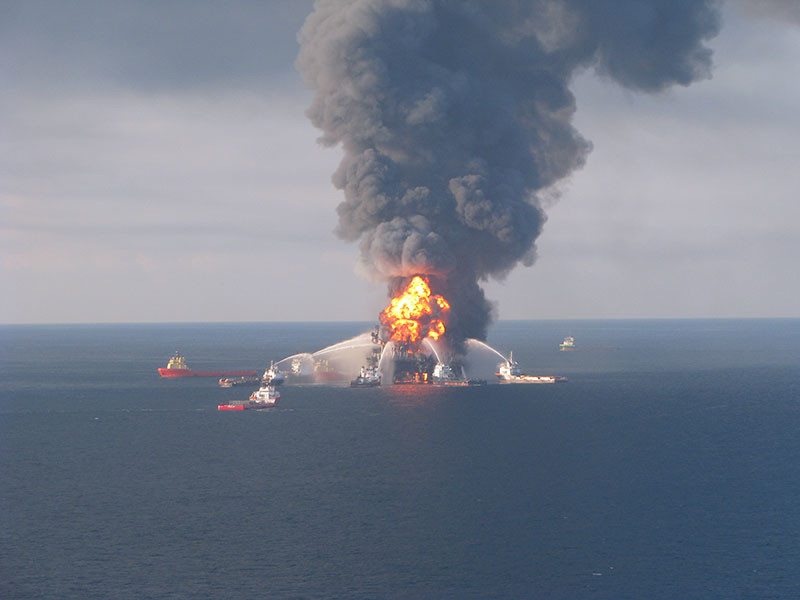The Deepwater Horizon blowout is still with us. Last week, the British newspaper The Guardian reported on the thousands of cleanup workers that are suffering adverse health impacts from the 2010 oil spill (Thursday was the 13th anniversary of the blowout and oil spill in the Gulf of Mexico).
As many as 33,000 people took part in the cleanup effort. The Guardian story focused on a half-dozen that are contending with long-term health issues they attribute to their participation in the cleanup, from chronic respiratory issues to cancer.
Given the toxicity of oil and hydrocarbon gases, and of Corexit, the dispersant used to prevent the spill from reaching the Gulf Coast and its estuaries, long-term illness among a not-insignificant number of workers would seem to be a given.
BP has paid $65 million for short-term medical illness claims. How long-term-health-related lawsuits will shake out remains to be seen. That’s a drop in the bucket compared with the $71 billion BP and its partners spent on remediation efforts in the decade following the spill, according to the Times-Picayune of New Orleans.
The Deepwater Horizon affairs is a solemn reminder that calculating the spillover costs of economic activity, in this case, energy production, is a necessary if complicated business. It may be possible to model impacts on tourism in the wake of an oil spill, or even lost harvests, but how does one assess the absence of wetlands or the demise of fish and wildlife? For that matter, as any of the sufferers in the Guardian article would tell you, spillover costs are not simply a matter of dollars and cents.
Once this would have been an academic discussion. We burned coal or wood and got power from steam. There were spillover costs, individual and societal, in the production of either fuel. Trees fell on lumberjacks. Coal was sooty and mines caved in. But there was not a lot of handwringing, or so it would seem. Steam powered the industrial revolution, and from the perspective of society, adverse impacts were vastly outweighed by steam’s benefits.
“Progress,” as Ronald Reagan would say, more than a century later, as a pitchman for General Electric, “is our most important product.”
Progress came to include the internal combustion engine and electrification, in which hydropower played a role.
Although the internal combustion engine is a polluter, the 20th-century diesel set the stage for the demise of much dirtier coal-fired steam locomotives, and by mid-century, coal’s days as a home heating fuel were on the wane in most of the country. Today, natural gas is the primary fuel for home heating systems.
In the second half of the 20th century, nuclear power was thought to be the solution to our ever-increasing thirst for energy, and a one-time Atomic Energy Commission chairman spoke (in 1954, no less), of “electrical energy too cheap to meter.”
Accidents at Three-Mile Island, Pa., Chernobyl in the Soviet Union, and more recently Fukushima, Japan, combined with the issue of nuclear waste disposal, seem to have cooled support for nuclear power in the United States.
Up until recently, innovation in the U.S. energy industry has been driven by consumer demand for more energy. But as we’ve seen, this can lead to unacceptable outcomes around safety, pollution, and even human health.
Oil has endured, but much of the world seems convinced that sun and wind will power the future. It’s cleaner power we need. But at what price?
No one is saying that oil is the final solution to the world’s energy needs. But no one has made the economic case that wind turbines and solar panels are the solution.
It’s one thing to put a few solar panels on the barn roof to cut costs over the next 20 years. But at scale they’re another matter. Up-front costs are high and better storage of electricity is needed. And aesthetically, solar farms are hideous.
Offshore wind turbines are unwanted by their neighbors, to say nothing of birds, and doubly so by the commercial fishing industry, which views them as getting rammed down its throat with little regard for traditional fishing grounds. Now developers of offshore wind are beginning to get cold feet, largely because of inflating costs.
Still, these energy sources will be embraced if they significantly reduce the cost of electricity. But it doesn’t sound like that day is just around the corner. The U.S. government believes wind will be a viable source of renewable energy by 2050.
Then again, there’s the Deepwater Horizon blowout. The fact is, between the Exxon Valdez and Deepwater Horizon, we had two catastrophic oil spills barely 20 years apart. Factor in the human costs of these spills, to say nothing of the billions spent in remediation, and the price of a barrel of oil goes up.
And these two spills are hardly the only ones that have taken place.
There are no magic wands, but there are practical ways to reduce emissions while keeping energy prices within reach of consumers.
Natural gas is ascendant — it’s now the largest source of U.S. electricity — and has one half the emissions of coals and two-thirds that of petroleum. Moreover, further reductions of emissions are within reach, for example, by minimizing methane leaks and capturing carbon dioxide emissions. And for 70 years, the Navy has demonstrated the practicality and safety of nuclear power.
There is no doubt a place for solar power, but it must be justified economically and technologically. There may be a place for offshore wind as well, but it must pay its way and turbines should not be sited over the objections of abutters ashore or to the obvious disadvantage of fishermen and other stakeholders at sea.
And we must put oil spills behind us, once and for all.



